Tesco's Business Strategy: Macro Environment & Strategic Planning
VerifiedAdded on 2023/06/07
|14
|4180
|369
Report
AI Summary
This report provides a comprehensive analysis of Tesco's business strategy, examining the impact of the macro environment using SWOT and PESTLE analyses, and evaluating the internal environment and capabilities with the McKinsey 7-S and VRIO frameworks. It applies Porter's Five Forces model to assess the competitive landscape, highlighting the potential of new entrants, the threat of substitutes, and the intensity of industry competition. The report also interprets and devises strategic planning for Tesco, considering factors like cost-saving, supply chain diversification, and technological advancements, ultimately aiming to provide insights into Tesco's strategic positioning and future direction. Desklib offers similar solved assignments and resources for students.
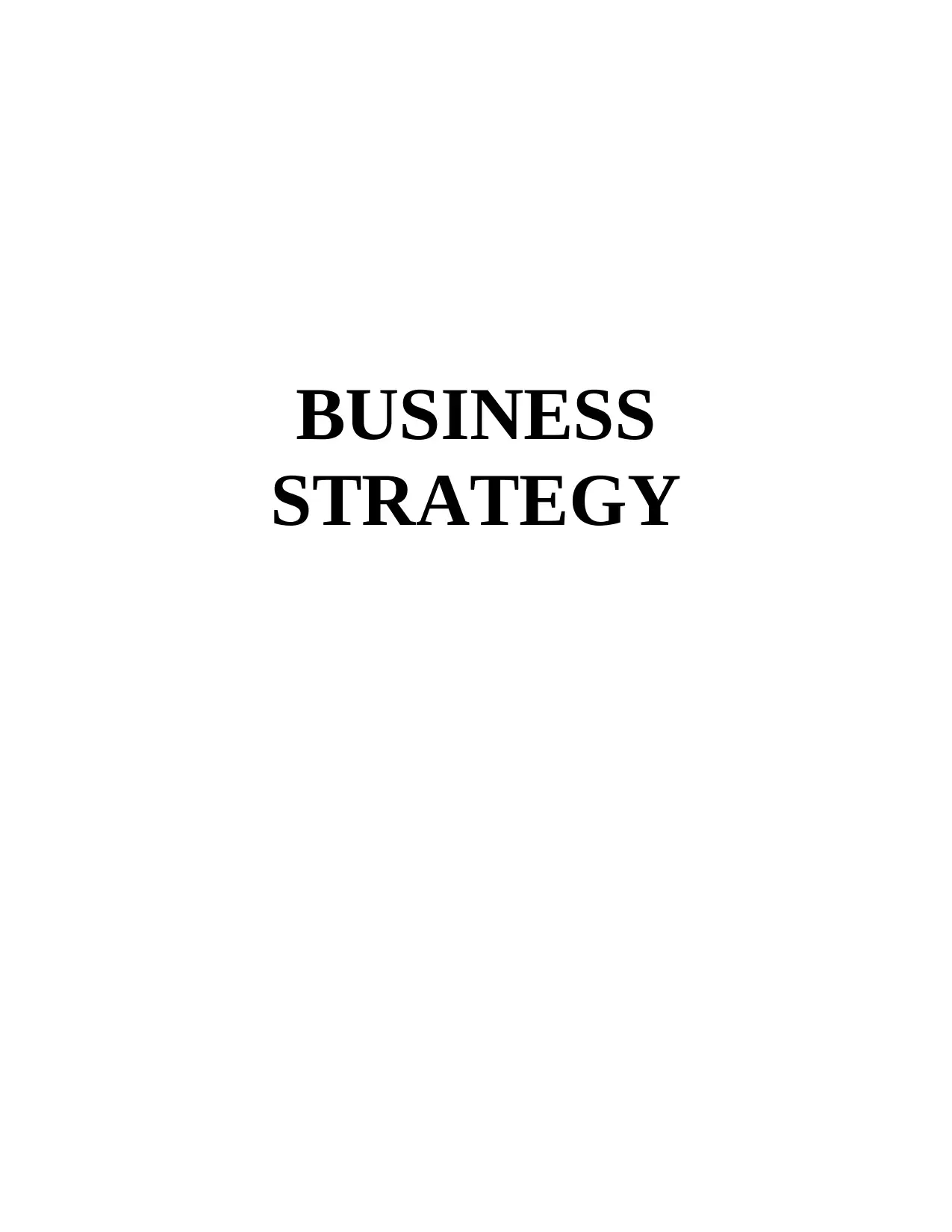
BUSINESS
STRATEGY
STRATEGY
Paraphrase This Document
Need a fresh take? Get an instant paraphrase of this document with our AI Paraphraser
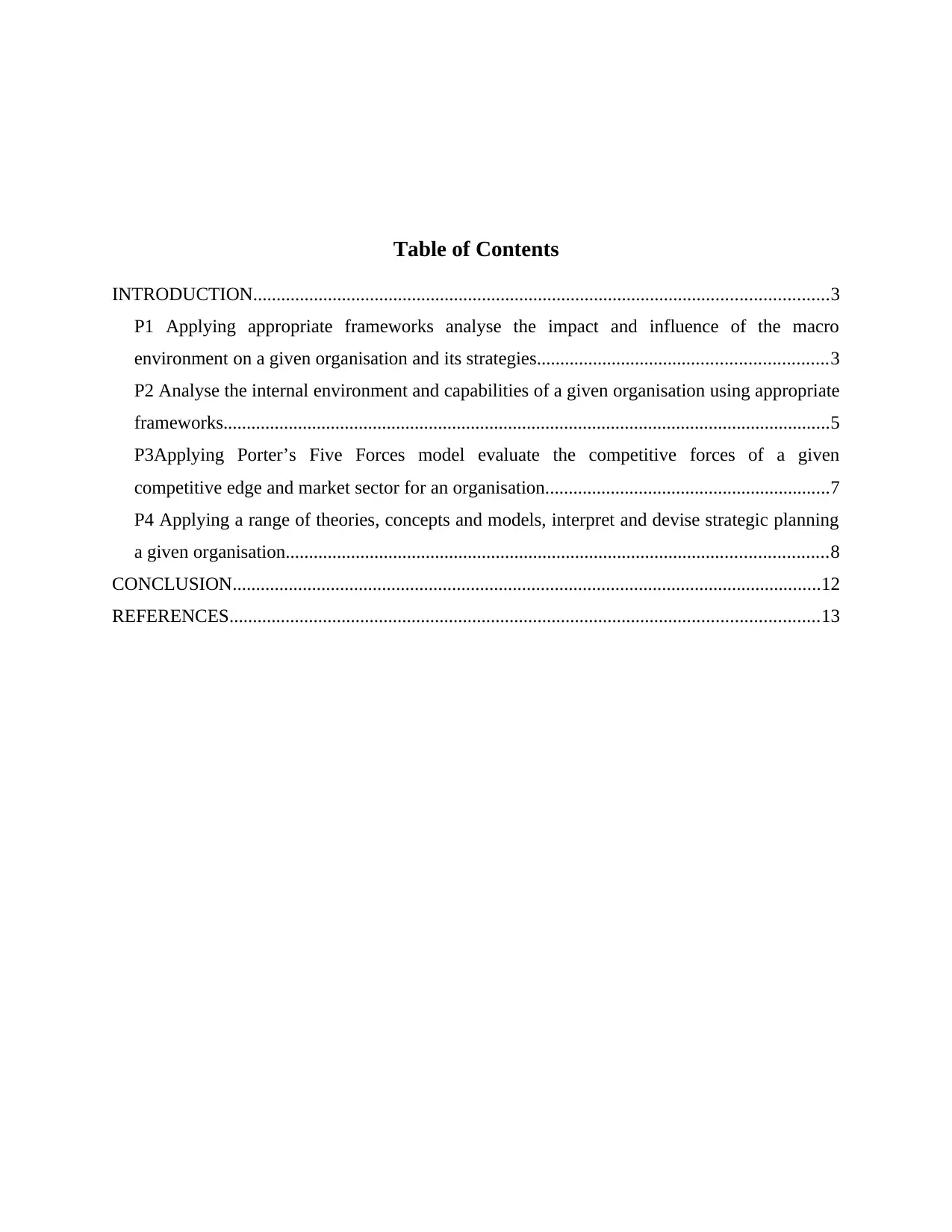
Table of Contents
INTRODUCTION...........................................................................................................................3
P1 Applying appropriate frameworks analyse the impact and influence of the macro
environment on a given organisation and its strategies..............................................................3
P2 Analyse the internal environment and capabilities of a given organisation using appropriate
frameworks..................................................................................................................................5
P3Applying Porter’s Five Forces model evaluate the competitive forces of a given
competitive edge and market sector for an organisation.............................................................7
P4 Applying a range of theories, concepts and models, interpret and devise strategic planning
a given organisation....................................................................................................................8
CONCLUSION..............................................................................................................................12
REFERENCES..............................................................................................................................13
INTRODUCTION...........................................................................................................................3
P1 Applying appropriate frameworks analyse the impact and influence of the macro
environment on a given organisation and its strategies..............................................................3
P2 Analyse the internal environment and capabilities of a given organisation using appropriate
frameworks..................................................................................................................................5
P3Applying Porter’s Five Forces model evaluate the competitive forces of a given
competitive edge and market sector for an organisation.............................................................7
P4 Applying a range of theories, concepts and models, interpret and devise strategic planning
a given organisation....................................................................................................................8
CONCLUSION..............................................................................................................................12
REFERENCES..............................................................................................................................13

INTRODUCTION
Business strategy is a combination of action required and decision making and principles that
helps in guiding the organisation regarding achieving business targets, action's required for
attracting costumer's towards the organisation and increase its revenue for the year in the terms
of money, goodwill, retaining its costumer. Business strategy helps in developing the business
and try to grow the business on the basis of the strategies organisation is applying on the
business. TESCO founded in 1919, hackney, London as a group of multiple market shops and
the founder of Tesco was Jack Cohen. It operates in retail industry and it has its headquarters in
Welwyn garden city, Hertfordshire England, UK, it has shops around the world between 4500 to
4600Kitsios, F. and et. al., (2018). it started as a grocery store in the late 1919 but now it has its
own several branches operating in different and in various market at the same time because it
started to open it started open its own mobile services, petrol and gas stations, grocery stores.
P1 Applying appropriate frameworks analyse the impact and influence of the macro environment
on a given organisation and its strategies.
SWOT analysis – Its main function is to analyse the strength, weakness, opportunities
and threats towards the organisation and also try to overcome those weakness and
because of this the business can probably found the opportunities in the market present
for the organisation in the particular market segment in which it mainly operates in and it
is further detailed below in the context of Tesco. Maniora, J., (2018).
Strength
Tesco has numerous number's of
strength like it has excellent customer
services, excels in retail department,
retain its customers by providing
various varieties at one place.
Weakness
Tesco has only one weakness that it
wasn't able to overcome from several
years now it is the increasing level of
debt, unfair business practices, negative
publicity .
Opportunities
Tesco's has various opportunities like
growing the online grocery sales, high
unemployment , rise in the demand of
plant based meat.
Threats
Tesco has some thereat that can effect
the organisation in various ways and
those are Brexit and supply chain,
economic recession, has several
Business strategy is a combination of action required and decision making and principles that
helps in guiding the organisation regarding achieving business targets, action's required for
attracting costumer's towards the organisation and increase its revenue for the year in the terms
of money, goodwill, retaining its costumer. Business strategy helps in developing the business
and try to grow the business on the basis of the strategies organisation is applying on the
business. TESCO founded in 1919, hackney, London as a group of multiple market shops and
the founder of Tesco was Jack Cohen. It operates in retail industry and it has its headquarters in
Welwyn garden city, Hertfordshire England, UK, it has shops around the world between 4500 to
4600Kitsios, F. and et. al., (2018). it started as a grocery store in the late 1919 but now it has its
own several branches operating in different and in various market at the same time because it
started to open it started open its own mobile services, petrol and gas stations, grocery stores.
P1 Applying appropriate frameworks analyse the impact and influence of the macro environment
on a given organisation and its strategies.
SWOT analysis – Its main function is to analyse the strength, weakness, opportunities
and threats towards the organisation and also try to overcome those weakness and
because of this the business can probably found the opportunities in the market present
for the organisation in the particular market segment in which it mainly operates in and it
is further detailed below in the context of Tesco. Maniora, J., (2018).
Strength
Tesco has numerous number's of
strength like it has excellent customer
services, excels in retail department,
retain its customers by providing
various varieties at one place.
Weakness
Tesco has only one weakness that it
wasn't able to overcome from several
years now it is the increasing level of
debt, unfair business practices, negative
publicity .
Opportunities
Tesco's has various opportunities like
growing the online grocery sales, high
unemployment , rise in the demand of
plant based meat.
Threats
Tesco has some thereat that can effect
the organisation in various ways and
those are Brexit and supply chain,
economic recession, has several
⊘ This is a preview!⊘
Do you want full access?
Subscribe today to unlock all pages.

Trusted by 1+ million students worldwide

competitors.
Pestle analysis - It is a framework used for analysis the macro environment of the
company which includes PESTEL factors contains Political, Economic, Social ,
Technological, Legal, Environmental are analysed by the marketers and detailed below.
Hsieh, and et, al.., (2018).
Political factor - TESCO operates in 44 countries including Asia and Europe. Political
factors that can effect TESCO are import duty because it also imports goods from
outside Europe and Asia like china and east Asia and the higher amount of import duties
can effect the profit margin of the company. Cubas‐Díaz, and et. al., (2018),
Economic factor - Labour cost is an important aspect as per the revenue or expense basis
. Its annual wage bill amounting GBP 4.5 billion .In 2018 UK minimum wage is
increased by 4.4% and it costed TESCO millions of pounds and this has costed Tesco
millions of pounds from this the profit of TESCO got affected drastically.,Munoz, and et.
al., 2018 And because of this matter it has lost its several customers and also faced a
drastic loss because of the
Social factors - Consumer shopping trends are constantly changing in recent times and
has to evolve for this example is obesity is major issue around the world and the TESCO
customers are more concerned about their healths and for this the TESCO has to consider
the changing in the buying behaviour .,Madhushree,and et. al., (2018).
Technological factors - Few years back was facing issues like poor costumer services .
Technological advancement helped TESCO regain its customer trust and taken advantage
of the opportunity to learn new technological things to cope up with other competitors .
Environmental factors - TESCO motivate its customers to buy online at tesco.com .
And Tesco has taken a initiative that its drivers will use fuel saving routes and collect
plastic bags from its customers and give them for recycling purpose.
Pestle analysis - It is a framework used for analysis the macro environment of the
company which includes PESTEL factors contains Political, Economic, Social ,
Technological, Legal, Environmental are analysed by the marketers and detailed below.
Hsieh, and et, al.., (2018).
Political factor - TESCO operates in 44 countries including Asia and Europe. Political
factors that can effect TESCO are import duty because it also imports goods from
outside Europe and Asia like china and east Asia and the higher amount of import duties
can effect the profit margin of the company. Cubas‐Díaz, and et. al., (2018),
Economic factor - Labour cost is an important aspect as per the revenue or expense basis
. Its annual wage bill amounting GBP 4.5 billion .In 2018 UK minimum wage is
increased by 4.4% and it costed TESCO millions of pounds and this has costed Tesco
millions of pounds from this the profit of TESCO got affected drastically.,Munoz, and et.
al., 2018 And because of this matter it has lost its several customers and also faced a
drastic loss because of the
Social factors - Consumer shopping trends are constantly changing in recent times and
has to evolve for this example is obesity is major issue around the world and the TESCO
customers are more concerned about their healths and for this the TESCO has to consider
the changing in the buying behaviour .,Madhushree,and et. al., (2018).
Technological factors - Few years back was facing issues like poor costumer services .
Technological advancement helped TESCO regain its customer trust and taken advantage
of the opportunity to learn new technological things to cope up with other competitors .
Environmental factors - TESCO motivate its customers to buy online at tesco.com .
And Tesco has taken a initiative that its drivers will use fuel saving routes and collect
plastic bags from its customers and give them for recycling purpose.
Paraphrase This Document
Need a fresh take? Get an instant paraphrase of this document with our AI Paraphraser
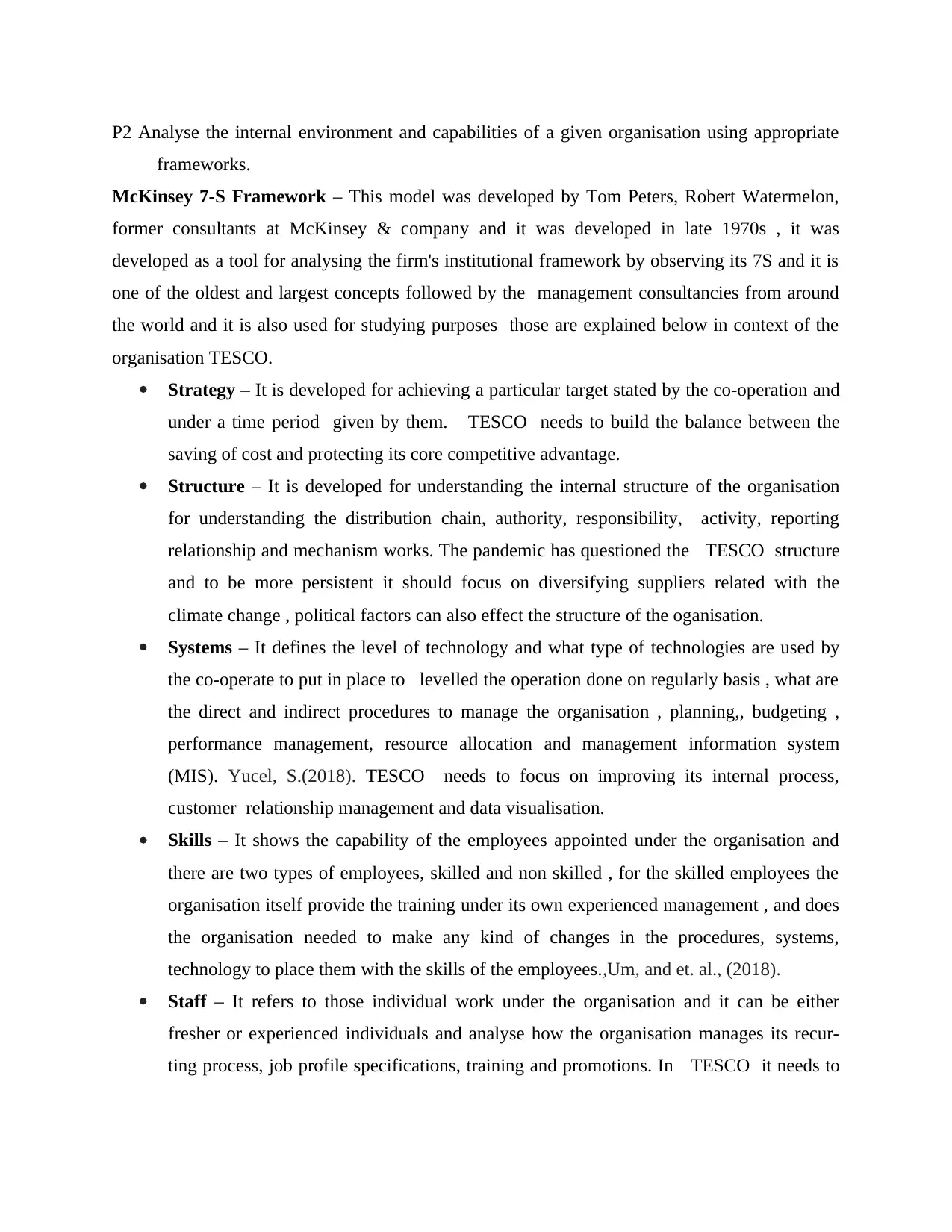
P2 Analyse the internal environment and capabilities of a given organisation using appropriate
frameworks.
McKinsey 7-S Framework – This model was developed by Tom Peters, Robert Watermelon,
former consultants at McKinsey & company and it was developed in late 1970s , it was
developed as a tool for analysing the firm's institutional framework by observing its 7S and it is
one of the oldest and largest concepts followed by the management consultancies from around
the world and it is also used for studying purposes those are explained below in context of the
organisation TESCO.
Strategy – It is developed for achieving a particular target stated by the co-operation and
under a time period given by them. TESCO needs to build the balance between the
saving of cost and protecting its core competitive advantage.
Structure – It is developed for understanding the internal structure of the organisation
for understanding the distribution chain, authority, responsibility, activity, reporting
relationship and mechanism works. The pandemic has questioned the TESCO structure
and to be more persistent it should focus on diversifying suppliers related with the
climate change , political factors can also effect the structure of the oganisation.
Systems – It defines the level of technology and what type of technologies are used by
the co-operate to put in place to levelled the operation done on regularly basis , what are
the direct and indirect procedures to manage the organisation , planning,, budgeting ,
performance management, resource allocation and management information system
(MIS). Yucel, S.(2018). TESCO needs to focus on improving its internal process,
customer relationship management and data visualisation.
Skills – It shows the capability of the employees appointed under the organisation and
there are two types of employees, skilled and non skilled , for the skilled employees the
organisation itself provide the training under its own experienced management , and does
the organisation needed to make any kind of changes in the procedures, systems,
technology to place them with the skills of the employees.,Um, and et. al., (2018).
Staff – It refers to those individual work under the organisation and it can be either
fresher or experienced individuals and analyse how the organisation manages its recur-
ting process, job profile specifications, training and promotions. In TESCO it needs to
frameworks.
McKinsey 7-S Framework – This model was developed by Tom Peters, Robert Watermelon,
former consultants at McKinsey & company and it was developed in late 1970s , it was
developed as a tool for analysing the firm's institutional framework by observing its 7S and it is
one of the oldest and largest concepts followed by the management consultancies from around
the world and it is also used for studying purposes those are explained below in context of the
organisation TESCO.
Strategy – It is developed for achieving a particular target stated by the co-operation and
under a time period given by them. TESCO needs to build the balance between the
saving of cost and protecting its core competitive advantage.
Structure – It is developed for understanding the internal structure of the organisation
for understanding the distribution chain, authority, responsibility, activity, reporting
relationship and mechanism works. The pandemic has questioned the TESCO structure
and to be more persistent it should focus on diversifying suppliers related with the
climate change , political factors can also effect the structure of the oganisation.
Systems – It defines the level of technology and what type of technologies are used by
the co-operate to put in place to levelled the operation done on regularly basis , what are
the direct and indirect procedures to manage the organisation , planning,, budgeting ,
performance management, resource allocation and management information system
(MIS). Yucel, S.(2018). TESCO needs to focus on improving its internal process,
customer relationship management and data visualisation.
Skills – It shows the capability of the employees appointed under the organisation and
there are two types of employees, skilled and non skilled , for the skilled employees the
organisation itself provide the training under its own experienced management , and does
the organisation needed to make any kind of changes in the procedures, systems,
technology to place them with the skills of the employees.,Um, and et. al., (2018).
Staff – It refers to those individual work under the organisation and it can be either
fresher or experienced individuals and analyse how the organisation manages its recur-
ting process, job profile specifications, training and promotions. In TESCO it needs to
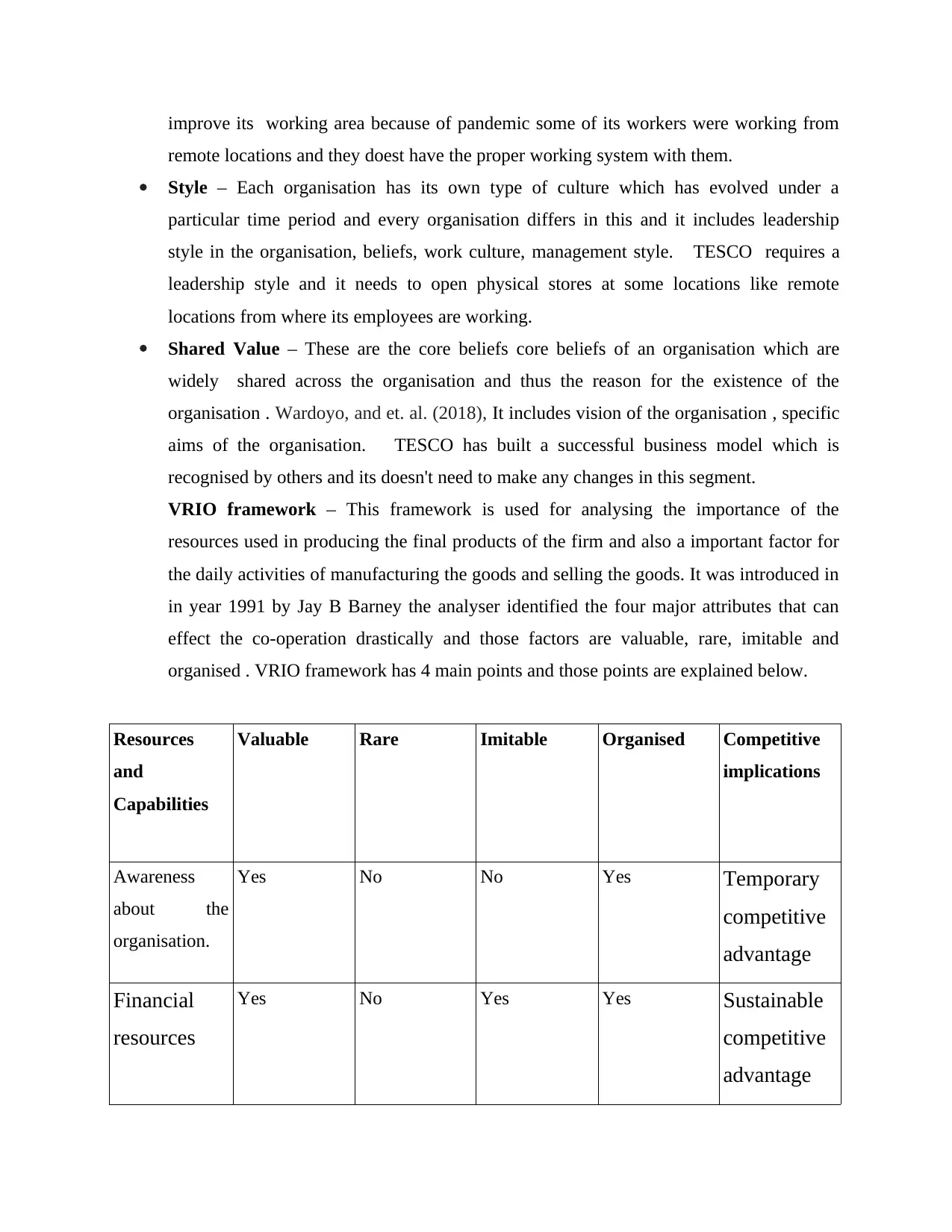
improve its working area because of pandemic some of its workers were working from
remote locations and they doest have the proper working system with them.
Style – Each organisation has its own type of culture which has evolved under a
particular time period and every organisation differs in this and it includes leadership
style in the organisation, beliefs, work culture, management style. TESCO requires a
leadership style and it needs to open physical stores at some locations like remote
locations from where its employees are working.
Shared Value – These are the core beliefs core beliefs of an organisation which are
widely shared across the organisation and thus the reason for the existence of the
organisation . Wardoyo, and et. al. (2018), It includes vision of the organisation , specific
aims of the organisation. TESCO has built a successful business model which is
recognised by others and its doesn't need to make any changes in this segment.
VRIO framework – This framework is used for analysing the importance of the
resources used in producing the final products of the firm and also a important factor for
the daily activities of manufacturing the goods and selling the goods. It was introduced in
in year 1991 by Jay B Barney the analyser identified the four major attributes that can
effect the co-operation drastically and those factors are valuable, rare, imitable and
organised . VRIO framework has 4 main points and those points are explained below.
Resources
and
Capabilities
Valuable Rare Imitable Organised Competitive
implications
Awareness
about the
organisation.
Yes No No Yes Temporary
competitive
advantage
Financial
resources
Yes No Yes Yes Sustainable
competitive
advantage
remote locations and they doest have the proper working system with them.
Style – Each organisation has its own type of culture which has evolved under a
particular time period and every organisation differs in this and it includes leadership
style in the organisation, beliefs, work culture, management style. TESCO requires a
leadership style and it needs to open physical stores at some locations like remote
locations from where its employees are working.
Shared Value – These are the core beliefs core beliefs of an organisation which are
widely shared across the organisation and thus the reason for the existence of the
organisation . Wardoyo, and et. al. (2018), It includes vision of the organisation , specific
aims of the organisation. TESCO has built a successful business model which is
recognised by others and its doesn't need to make any changes in this segment.
VRIO framework – This framework is used for analysing the importance of the
resources used in producing the final products of the firm and also a important factor for
the daily activities of manufacturing the goods and selling the goods. It was introduced in
in year 1991 by Jay B Barney the analyser identified the four major attributes that can
effect the co-operation drastically and those factors are valuable, rare, imitable and
organised . VRIO framework has 4 main points and those points are explained below.
Resources
and
Capabilities
Valuable Rare Imitable Organised Competitive
implications
Awareness
about the
organisation.
Yes No No Yes Temporary
competitive
advantage
Financial
resources
Yes No Yes Yes Sustainable
competitive
advantage
⊘ This is a preview!⊘
Do you want full access?
Subscribe today to unlock all pages.

Trusted by 1+ million students worldwide
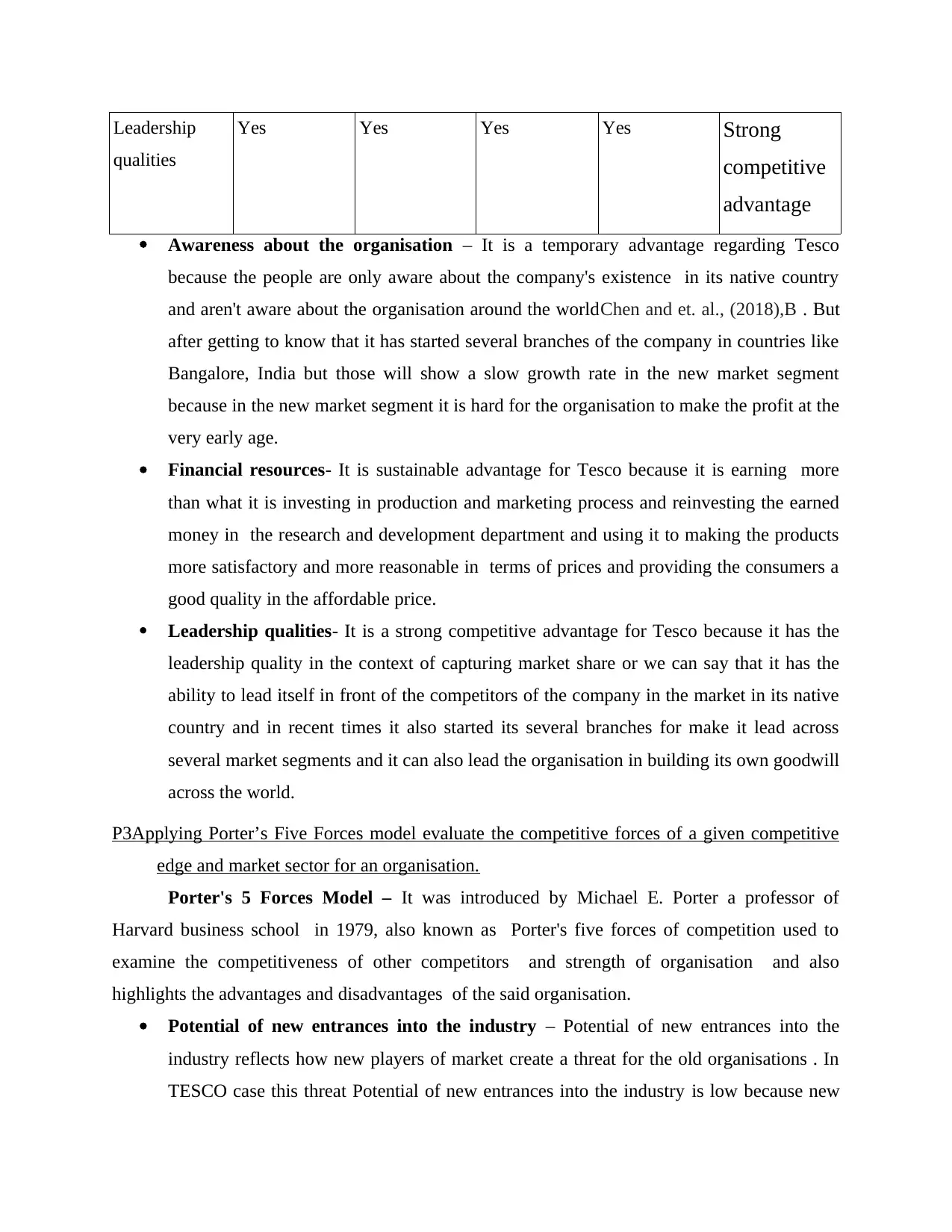
Leadership
qualities
Yes Yes Yes Yes Strong
competitive
advantage
Awareness about the organisation – It is a temporary advantage regarding Tesco
because the people are only aware about the company's existence in its native country
and aren't aware about the organisation around the worldChen and et. al., (2018),B . But
after getting to know that it has started several branches of the company in countries like
Bangalore, India but those will show a slow growth rate in the new market segment
because in the new market segment it is hard for the organisation to make the profit at the
very early age.
Financial resources- It is sustainable advantage for Tesco because it is earning more
than what it is investing in production and marketing process and reinvesting the earned
money in the research and development department and using it to making the products
more satisfactory and more reasonable in terms of prices and providing the consumers a
good quality in the affordable price.
Leadership qualities- It is a strong competitive advantage for Tesco because it has the
leadership quality in the context of capturing market share or we can say that it has the
ability to lead itself in front of the competitors of the company in the market in its native
country and in recent times it also started its several branches for make it lead across
several market segments and it can also lead the organisation in building its own goodwill
across the world.
P3Applying Porter’s Five Forces model evaluate the competitive forces of a given competitive
edge and market sector for an organisation.
Porter's 5 Forces Model – It was introduced by Michael E. Porter a professor of
Harvard business school in 1979, also known as Porter's five forces of competition used to
examine the competitiveness of other competitors and strength of organisation and also
highlights the advantages and disadvantages of the said organisation.
Potential of new entrances into the industry – Potential of new entrances into the
industry reflects how new players of market create a threat for the old organisations . In
TESCO case this threat Potential of new entrances into the industry is low because new
qualities
Yes Yes Yes Yes Strong
competitive
advantage
Awareness about the organisation – It is a temporary advantage regarding Tesco
because the people are only aware about the company's existence in its native country
and aren't aware about the organisation around the worldChen and et. al., (2018),B . But
after getting to know that it has started several branches of the company in countries like
Bangalore, India but those will show a slow growth rate in the new market segment
because in the new market segment it is hard for the organisation to make the profit at the
very early age.
Financial resources- It is sustainable advantage for Tesco because it is earning more
than what it is investing in production and marketing process and reinvesting the earned
money in the research and development department and using it to making the products
more satisfactory and more reasonable in terms of prices and providing the consumers a
good quality in the affordable price.
Leadership qualities- It is a strong competitive advantage for Tesco because it has the
leadership quality in the context of capturing market share or we can say that it has the
ability to lead itself in front of the competitors of the company in the market in its native
country and in recent times it also started its several branches for make it lead across
several market segments and it can also lead the organisation in building its own goodwill
across the world.
P3Applying Porter’s Five Forces model evaluate the competitive forces of a given competitive
edge and market sector for an organisation.
Porter's 5 Forces Model – It was introduced by Michael E. Porter a professor of
Harvard business school in 1979, also known as Porter's five forces of competition used to
examine the competitiveness of other competitors and strength of organisation and also
highlights the advantages and disadvantages of the said organisation.
Potential of new entrances into the industry – Potential of new entrances into the
industry reflects how new players of market create a threat for the old organisations . In
TESCO case this threat Potential of new entrances into the industry is low because new
Paraphrase This Document
Need a fresh take? Get an instant paraphrase of this document with our AI Paraphraser
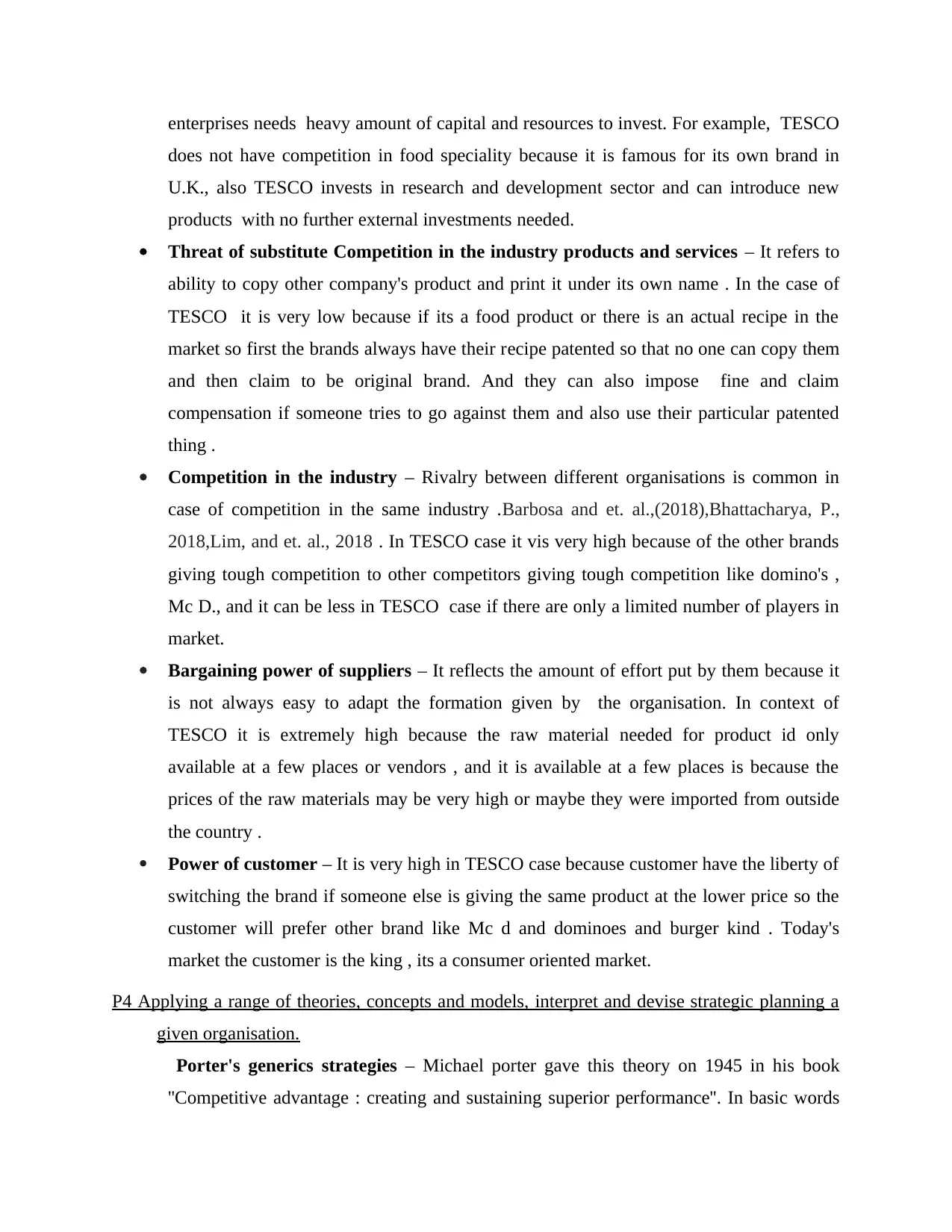
enterprises needs heavy amount of capital and resources to invest. For example, TESCO
does not have competition in food speciality because it is famous for its own brand in
U.K., also TESCO invests in research and development sector and can introduce new
products with no further external investments needed.
Threat of substitute Competition in the industry products and services – It refers to
ability to copy other company's product and print it under its own name . In the case of
TESCO it is very low because if its a food product or there is an actual recipe in the
market so first the brands always have their recipe patented so that no one can copy them
and then claim to be original brand. And they can also impose fine and claim
compensation if someone tries to go against them and also use their particular patented
thing .
Competition in the industry – Rivalry between different organisations is common in
case of competition in the same industry .Barbosa and et. al.,(2018),Bhattacharya, P.,
2018,Lim, and et. al., 2018 . In TESCO case it vis very high because of the other brands
giving tough competition to other competitors giving tough competition like domino's ,
Mc D., and it can be less in TESCO case if there are only a limited number of players in
market.
Bargaining power of suppliers – It reflects the amount of effort put by them because it
is not always easy to adapt the formation given by the organisation. In context of
TESCO it is extremely high because the raw material needed for product id only
available at a few places or vendors , and it is available at a few places is because the
prices of the raw materials may be very high or maybe they were imported from outside
the country .
Power of customer – It is very high in TESCO case because customer have the liberty of
switching the brand if someone else is giving the same product at the lower price so the
customer will prefer other brand like Mc d and dominoes and burger kind . Today's
market the customer is the king , its a consumer oriented market.
P4 Applying a range of theories, concepts and models, interpret and devise strategic planning a
given organisation.
Porter's generics strategies – Michael porter gave this theory on 1945 in his book
''Competitive advantage : creating and sustaining superior performance''. In basic words
does not have competition in food speciality because it is famous for its own brand in
U.K., also TESCO invests in research and development sector and can introduce new
products with no further external investments needed.
Threat of substitute Competition in the industry products and services – It refers to
ability to copy other company's product and print it under its own name . In the case of
TESCO it is very low because if its a food product or there is an actual recipe in the
market so first the brands always have their recipe patented so that no one can copy them
and then claim to be original brand. And they can also impose fine and claim
compensation if someone tries to go against them and also use their particular patented
thing .
Competition in the industry – Rivalry between different organisations is common in
case of competition in the same industry .Barbosa and et. al.,(2018),Bhattacharya, P.,
2018,Lim, and et. al., 2018 . In TESCO case it vis very high because of the other brands
giving tough competition to other competitors giving tough competition like domino's ,
Mc D., and it can be less in TESCO case if there are only a limited number of players in
market.
Bargaining power of suppliers – It reflects the amount of effort put by them because it
is not always easy to adapt the formation given by the organisation. In context of
TESCO it is extremely high because the raw material needed for product id only
available at a few places or vendors , and it is available at a few places is because the
prices of the raw materials may be very high or maybe they were imported from outside
the country .
Power of customer – It is very high in TESCO case because customer have the liberty of
switching the brand if someone else is giving the same product at the lower price so the
customer will prefer other brand like Mc d and dominoes and burger kind . Today's
market the customer is the king , its a consumer oriented market.
P4 Applying a range of theories, concepts and models, interpret and devise strategic planning a
given organisation.
Porter's generics strategies – Michael porter gave this theory on 1945 in his book
''Competitive advantage : creating and sustaining superior performance''. In basic words
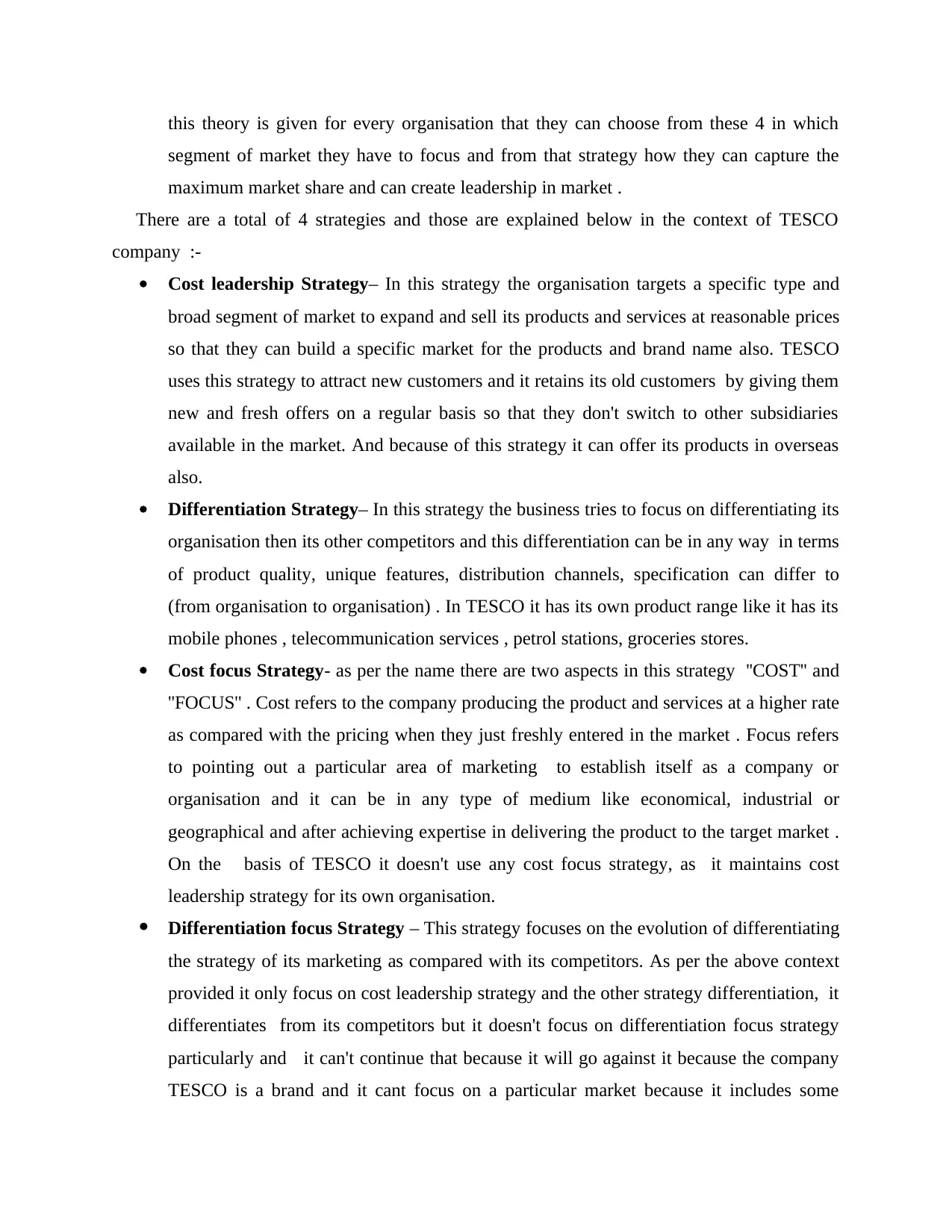
this theory is given for every organisation that they can choose from these 4 in which
segment of market they have to focus and from that strategy how they can capture the
maximum market share and can create leadership in market .
There are a total of 4 strategies and those are explained below in the context of TESCO
company :-
Cost leadership Strategy– In this strategy the organisation targets a specific type and
broad segment of market to expand and sell its products and services at reasonable prices
so that they can build a specific market for the products and brand name also. TESCO
uses this strategy to attract new customers and it retains its old customers by giving them
new and fresh offers on a regular basis so that they don't switch to other subsidiaries
available in the market. And because of this strategy it can offer its products in overseas
also.
Differentiation Strategy– In this strategy the business tries to focus on differentiating its
organisation then its other competitors and this differentiation can be in any way in terms
of product quality, unique features, distribution channels, specification can differ to
(from organisation to organisation) . In TESCO it has its own product range like it has its
mobile phones , telecommunication services , petrol stations, groceries stores.
Cost focus Strategy- as per the name there are two aspects in this strategy ''COST'' and
''FOCUS'' . Cost refers to the company producing the product and services at a higher rate
as compared with the pricing when they just freshly entered in the market . Focus refers
to pointing out a particular area of marketing to establish itself as a company or
organisation and it can be in any type of medium like economical, industrial or
geographical and after achieving expertise in delivering the product to the target market .
On the basis of TESCO it doesn't use any cost focus strategy, as it maintains cost
leadership strategy for its own organisation.
Differentiation focus Strategy – This strategy focuses on the evolution of differentiating
the strategy of its marketing as compared with its competitors. As per the above context
provided it only focus on cost leadership strategy and the other strategy differentiation, it
differentiates from its competitors but it doesn't focus on differentiation focus strategy
particularly and it can't continue that because it will go against it because the company
TESCO is a brand and it cant focus on a particular market because it includes some
segment of market they have to focus and from that strategy how they can capture the
maximum market share and can create leadership in market .
There are a total of 4 strategies and those are explained below in the context of TESCO
company :-
Cost leadership Strategy– In this strategy the organisation targets a specific type and
broad segment of market to expand and sell its products and services at reasonable prices
so that they can build a specific market for the products and brand name also. TESCO
uses this strategy to attract new customers and it retains its old customers by giving them
new and fresh offers on a regular basis so that they don't switch to other subsidiaries
available in the market. And because of this strategy it can offer its products in overseas
also.
Differentiation Strategy– In this strategy the business tries to focus on differentiating its
organisation then its other competitors and this differentiation can be in any way in terms
of product quality, unique features, distribution channels, specification can differ to
(from organisation to organisation) . In TESCO it has its own product range like it has its
mobile phones , telecommunication services , petrol stations, groceries stores.
Cost focus Strategy- as per the name there are two aspects in this strategy ''COST'' and
''FOCUS'' . Cost refers to the company producing the product and services at a higher rate
as compared with the pricing when they just freshly entered in the market . Focus refers
to pointing out a particular area of marketing to establish itself as a company or
organisation and it can be in any type of medium like economical, industrial or
geographical and after achieving expertise in delivering the product to the target market .
On the basis of TESCO it doesn't use any cost focus strategy, as it maintains cost
leadership strategy for its own organisation.
Differentiation focus Strategy – This strategy focuses on the evolution of differentiating
the strategy of its marketing as compared with its competitors. As per the above context
provided it only focus on cost leadership strategy and the other strategy differentiation, it
differentiates from its competitors but it doesn't focus on differentiation focus strategy
particularly and it can't continue that because it will go against it because the company
TESCO is a brand and it cant focus on a particular market because it includes some
⊘ This is a preview!⊘
Do you want full access?
Subscribe today to unlock all pages.

Trusted by 1+ million students worldwide
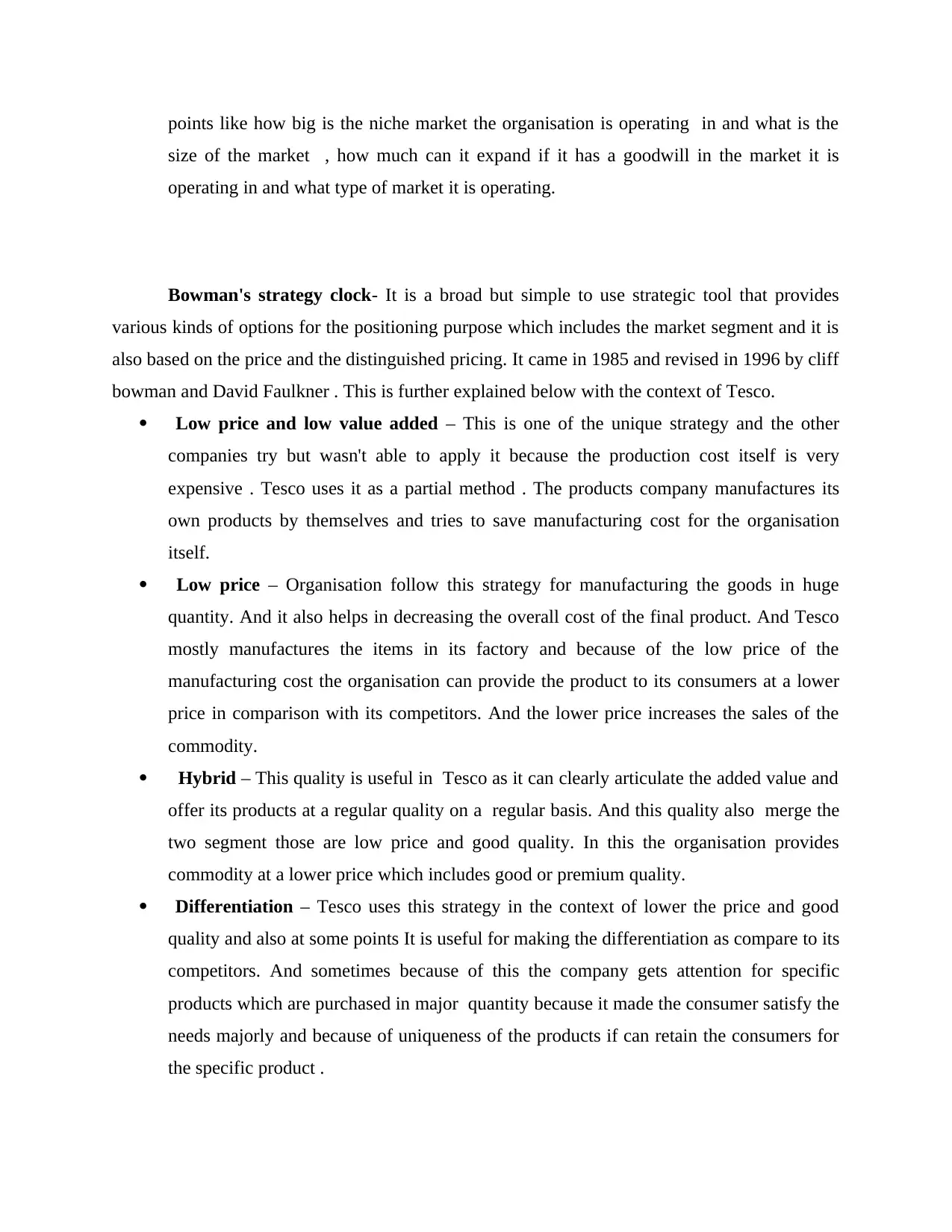
points like how big is the niche market the organisation is operating in and what is the
size of the market , how much can it expand if it has a goodwill in the market it is
operating in and what type of market it is operating.
Bowman's strategy clock- It is a broad but simple to use strategic tool that provides
various kinds of options for the positioning purpose which includes the market segment and it is
also based on the price and the distinguished pricing. It came in 1985 and revised in 1996 by cliff
bowman and David Faulkner . This is further explained below with the context of Tesco.
Low price and low value added – This is one of the unique strategy and the other
companies try but wasn't able to apply it because the production cost itself is very
expensive . Tesco uses it as a partial method . The products company manufactures its
own products by themselves and tries to save manufacturing cost for the organisation
itself.
Low price – Organisation follow this strategy for manufacturing the goods in huge
quantity. And it also helps in decreasing the overall cost of the final product. And Tesco
mostly manufactures the items in its factory and because of the low price of the
manufacturing cost the organisation can provide the product to its consumers at a lower
price in comparison with its competitors. And the lower price increases the sales of the
commodity.
Hybrid – This quality is useful in Tesco as it can clearly articulate the added value and
offer its products at a regular quality on a regular basis. And this quality also merge the
two segment those are low price and good quality. In this the organisation provides
commodity at a lower price which includes good or premium quality.
Differentiation – Tesco uses this strategy in the context of lower the price and good
quality and also at some points It is useful for making the differentiation as compare to its
competitors. And sometimes because of this the company gets attention for specific
products which are purchased in major quantity because it made the consumer satisfy the
needs majorly and because of uniqueness of the products if can retain the consumers for
the specific product .
size of the market , how much can it expand if it has a goodwill in the market it is
operating in and what type of market it is operating.
Bowman's strategy clock- It is a broad but simple to use strategic tool that provides
various kinds of options for the positioning purpose which includes the market segment and it is
also based on the price and the distinguished pricing. It came in 1985 and revised in 1996 by cliff
bowman and David Faulkner . This is further explained below with the context of Tesco.
Low price and low value added – This is one of the unique strategy and the other
companies try but wasn't able to apply it because the production cost itself is very
expensive . Tesco uses it as a partial method . The products company manufactures its
own products by themselves and tries to save manufacturing cost for the organisation
itself.
Low price – Organisation follow this strategy for manufacturing the goods in huge
quantity. And it also helps in decreasing the overall cost of the final product. And Tesco
mostly manufactures the items in its factory and because of the low price of the
manufacturing cost the organisation can provide the product to its consumers at a lower
price in comparison with its competitors. And the lower price increases the sales of the
commodity.
Hybrid – This quality is useful in Tesco as it can clearly articulate the added value and
offer its products at a regular quality on a regular basis. And this quality also merge the
two segment those are low price and good quality. In this the organisation provides
commodity at a lower price which includes good or premium quality.
Differentiation – Tesco uses this strategy in the context of lower the price and good
quality and also at some points It is useful for making the differentiation as compare to its
competitors. And sometimes because of this the company gets attention for specific
products which are purchased in major quantity because it made the consumer satisfy the
needs majorly and because of uniqueness of the products if can retain the consumers for
the specific product .
Paraphrase This Document
Need a fresh take? Get an instant paraphrase of this document with our AI Paraphraser
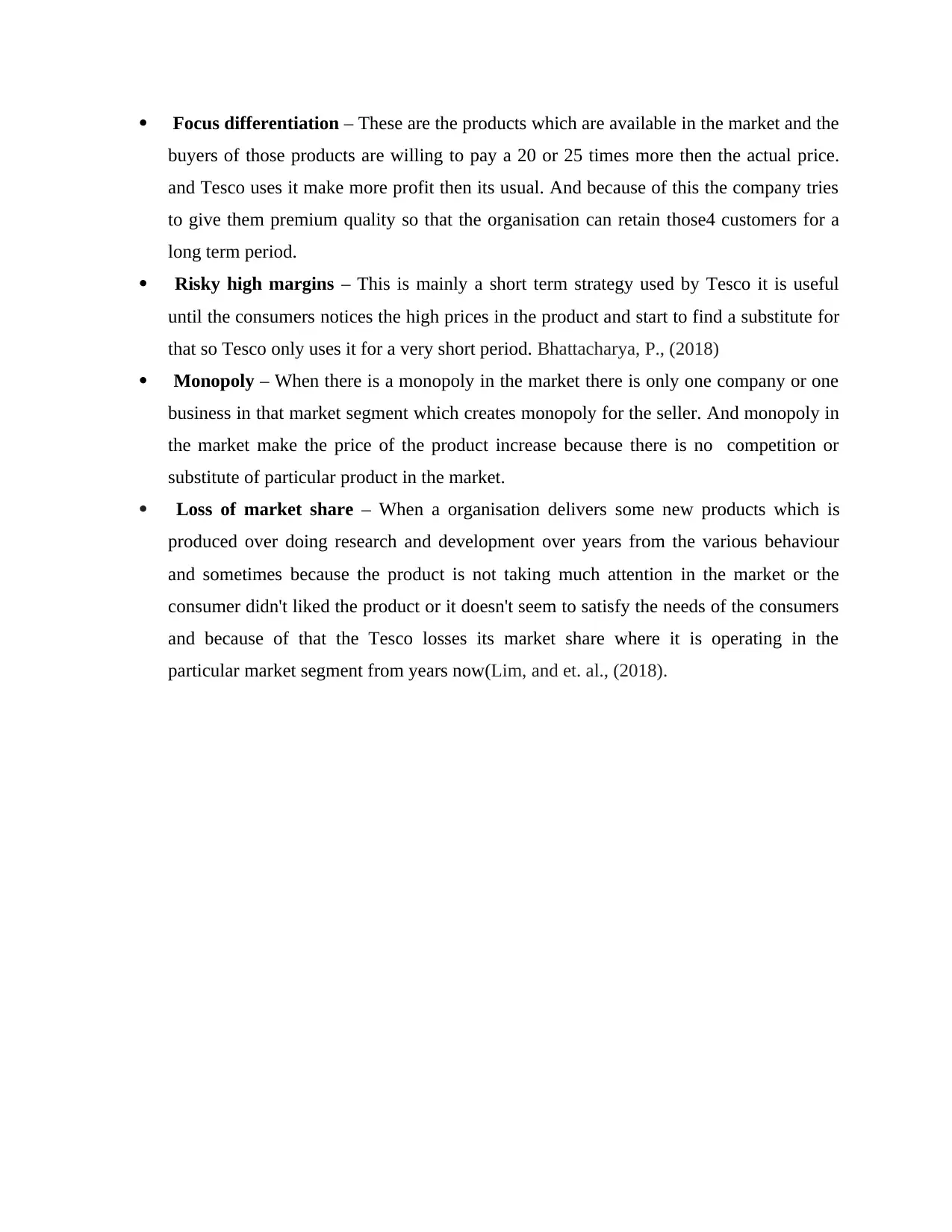
Focus differentiation – These are the products which are available in the market and the
buyers of those products are willing to pay a 20 or 25 times more then the actual price.
and Tesco uses it make more profit then its usual. And because of this the company tries
to give them premium quality so that the organisation can retain those4 customers for a
long term period.
Risky high margins – This is mainly a short term strategy used by Tesco it is useful
until the consumers notices the high prices in the product and start to find a substitute for
that so Tesco only uses it for a very short period. Bhattacharya, P., (2018)
Monopoly – When there is a monopoly in the market there is only one company or one
business in that market segment which creates monopoly for the seller. And monopoly in
the market make the price of the product increase because there is no competition or
substitute of particular product in the market.
Loss of market share – When a organisation delivers some new products which is
produced over doing research and development over years from the various behaviour
and sometimes because the product is not taking much attention in the market or the
consumer didn't liked the product or it doesn't seem to satisfy the needs of the consumers
and because of that the Tesco losses its market share where it is operating in the
particular market segment from years now(Lim, and et. al., (2018).
buyers of those products are willing to pay a 20 or 25 times more then the actual price.
and Tesco uses it make more profit then its usual. And because of this the company tries
to give them premium quality so that the organisation can retain those4 customers for a
long term period.
Risky high margins – This is mainly a short term strategy used by Tesco it is useful
until the consumers notices the high prices in the product and start to find a substitute for
that so Tesco only uses it for a very short period. Bhattacharya, P., (2018)
Monopoly – When there is a monopoly in the market there is only one company or one
business in that market segment which creates monopoly for the seller. And monopoly in
the market make the price of the product increase because there is no competition or
substitute of particular product in the market.
Loss of market share – When a organisation delivers some new products which is
produced over doing research and development over years from the various behaviour
and sometimes because the product is not taking much attention in the market or the
consumer didn't liked the product or it doesn't seem to satisfy the needs of the consumers
and because of that the Tesco losses its market share where it is operating in the
particular market segment from years now(Lim, and et. al., (2018).
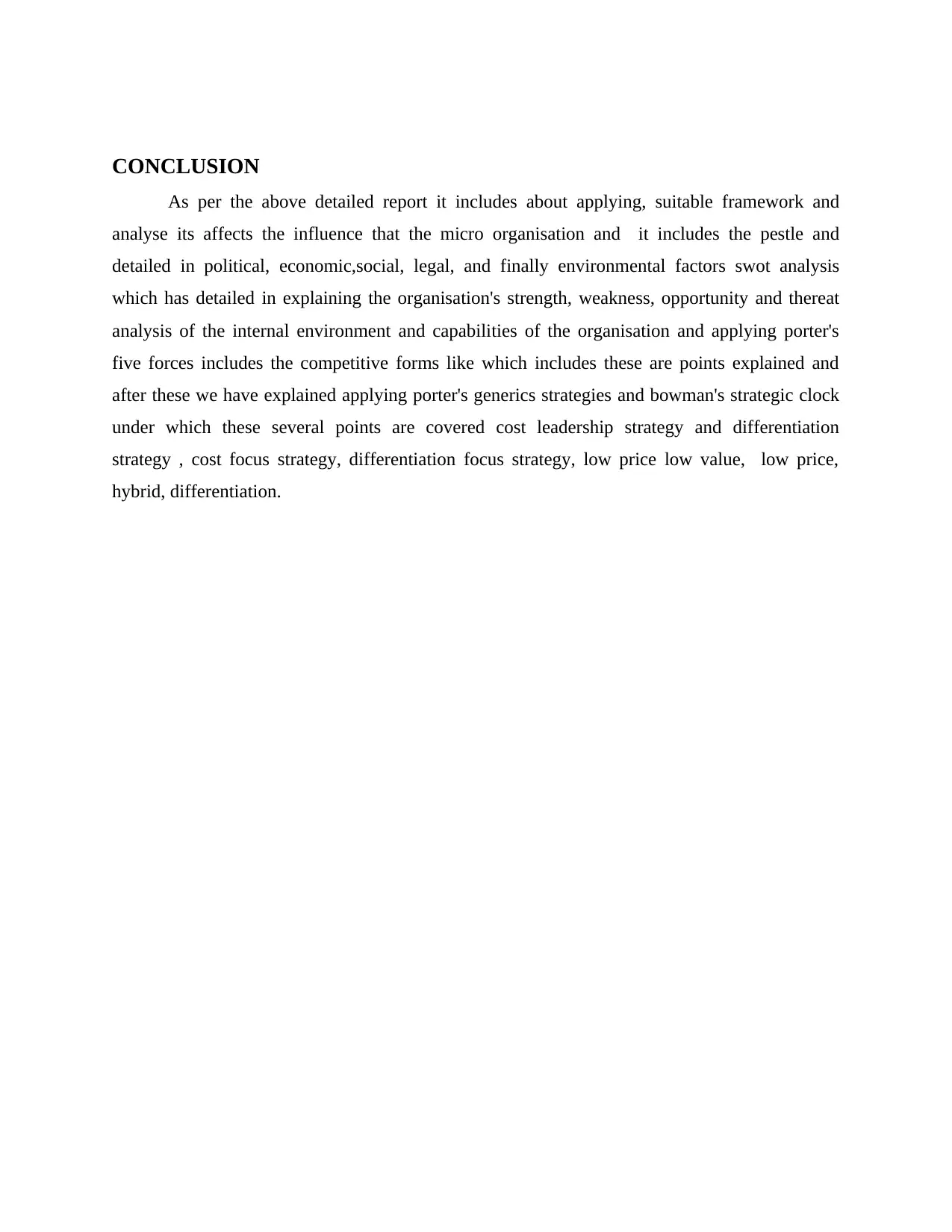
CONCLUSION
As per the above detailed report it includes about applying, suitable framework and
analyse its affects the influence that the micro organisation and it includes the pestle and
detailed in political, economic,social, legal, and finally environmental factors swot analysis
which has detailed in explaining the organisation's strength, weakness, opportunity and thereat
analysis of the internal environment and capabilities of the organisation and applying porter's
five forces includes the competitive forms like which includes these are points explained and
after these we have explained applying porter's generics strategies and bowman's strategic clock
under which these several points are covered cost leadership strategy and differentiation
strategy , cost focus strategy, differentiation focus strategy, low price low value, low price,
hybrid, differentiation.
As per the above detailed report it includes about applying, suitable framework and
analyse its affects the influence that the micro organisation and it includes the pestle and
detailed in political, economic,social, legal, and finally environmental factors swot analysis
which has detailed in explaining the organisation's strength, weakness, opportunity and thereat
analysis of the internal environment and capabilities of the organisation and applying porter's
five forces includes the competitive forms like which includes these are points explained and
after these we have explained applying porter's generics strategies and bowman's strategic clock
under which these several points are covered cost leadership strategy and differentiation
strategy , cost focus strategy, differentiation focus strategy, low price low value, low price,
hybrid, differentiation.
⊘ This is a preview!⊘
Do you want full access?
Subscribe today to unlock all pages.

Trusted by 1+ million students worldwide
1 out of 14
Related Documents
Your All-in-One AI-Powered Toolkit for Academic Success.
+13062052269
info@desklib.com
Available 24*7 on WhatsApp / Email
![[object Object]](/_next/static/media/star-bottom.7253800d.svg)
Unlock your academic potential
Copyright © 2020–2025 A2Z Services. All Rights Reserved. Developed and managed by ZUCOL.




